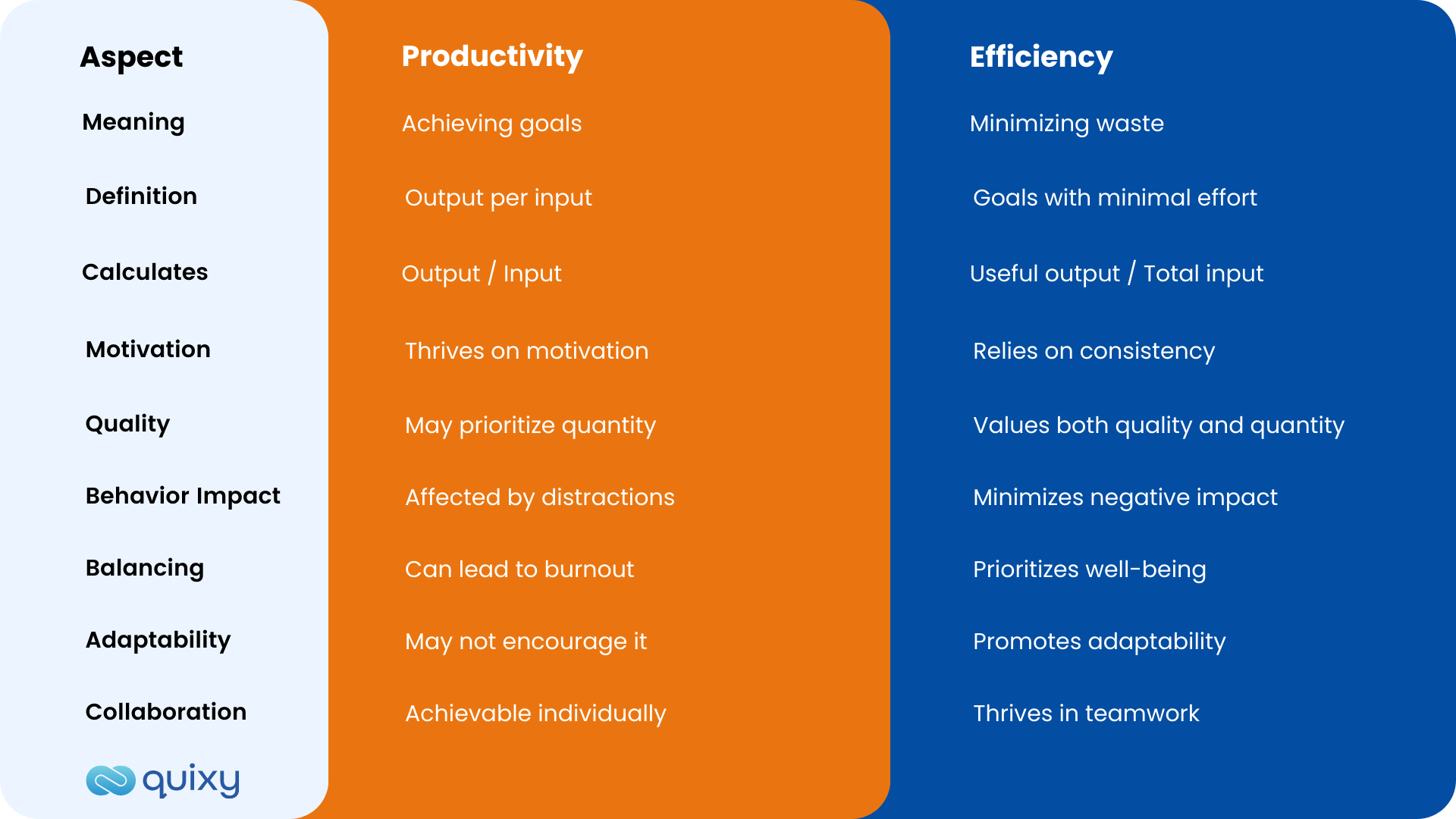
Whenever you start or accomplish any task, you must have used or come across the words “efficiency” and ‘productivity.” These two words are often used interchangeably. In case you still have doubts about whether these two words are identical or have some different meanings, then don’t worry. We will clear all your queries through this blog.
In this blog post, we will cover the difference between productivity and efficiency and correlations, how you can calculate efficiency and productivity, and the importance of productivity and efficiency in business.
Understanding Productivity
Productivity can be described as the measure of how efficiently any organization can utilize its available resources to generate goods or services. In short, productivity measures the final output any organization can produce for each input unit.
The prior objective of productivity is to make sure that there is utilization of the available resources, including time, labor, and time, in such a manner that it can maximize profitability and efficiency.
By enhancing the level of productivity and reducing the cost, a company or business can become more efficient and competitive.
Depending upon the industry in which you operate your business, there are various ways to evaluate productivity. However, some of the common measures include revenue per square foot or sales per employee.
Also Read: Workplace Productivity: What is it and how to measure it?
Understanding Efficiency
When we talk about business efficiency, it defines the capability of any organization to minimize its time, effort, as well material while at the same time enhancing its profitability.
If we closely observe from a financial landscape, then efficiency can be defined by the correlation between the input and output of any organization.
In this case, the input is the resources that are essential to keep the operation ongoing, for instance, time, money, and the employees who are working for that particular organization.
Whereas the outcome can be described as the final outcome made by the company that covers customer acquisition, quality, and revenue.
Now you must be thinking what is the role or significance of the level of efficiency in any organization well, the answer is quite simple.
It becomes a tough task when you have to keep track of and improve the financial proficiency of any organization. If you are aware of the company’s efficiency, then you can easily optimize the effort, time, and money to enhance the profit of the company in the long term.
Also Explore: The Impact of Quixy on Business Performance: A Digital Transformation Catalyst
Factors that affect productivity
Low productivity in business or the workplace is not something uncommon. But you can always rectify this, and you recognize where you are lagging. Here are some of the major reasons behind the low productivity:
1. Multitasking
Imagine you have been given two projects at a time, and the deadline is the next day, Now you had this in your mind that you have to finish it up before the headline, and for this reason, you started working on both projects at a time.
This will cause nothing but lots of stress to accomplish the tasks beforehand. This is a clear indication of low productivity. You will neither be able to deliver work on time nor keep your focus on a single task.
2. Stress at your workplace
Another major reason behind the low productivity is stress at your workplace. It can happen because of multiple reasons, such as lack of concentration, getting distracted, or your team being overburdened with the work pressure. All these things are clear signs of stress in the workplace.
3. Lack of acknowledgment of your work
Acknowledging the work done by the employees is the easiest way to manage and motivate the team. One of the key factors that affects productivity is lack of acknowledgment.
For instance, you have worked really hard to accomplish a task, and the final output becomes an asset for the company or business, The bare minimum gesture an employee would ever expect is an acknowledgment of their contribution to this entire task.
Most of the time, people neglect their team in terms of recognizing their contribution to the task. That becomes a reason behind low productivity in many cases.
4. Poor management
Last but not least reason behind the low productivity is poor management. In many cases, it was observed that managers do micromanagement, which directly affects the workflow of an employee.
No foolproof strategy, time management, and lack of clarity in achieving the final output are the factors that come under poor management. All these things can collectively cause low productivity for any company.
Also Read: Achieving Efficiency Amid Automation Challenges
Factors that affect the efficiency
With the help of automation technology, you can easily monitor and report the level of efficiency in your company. There are different types of factors that can affect efficiency, which include:
1. Cutting off redundancy
One of the most common factors that can affect the efficiency of the company is redundancy or ineffective procedures in place. Most of the time, organizations keep the process because they have always done this; irrespective of this fact, the it is outdated and needs process improvement. Later on, these outdated methods can affect the growth of the company.
Periodic audits are one of the most essential factors for the growth of any company. By cutting off these redundant procedures, companies can improve their efficiency and easily streamline the entire workflow. The primary motto of the company is to include value-added systems and practices that will be satisfied by cutting off redundancy from the system.
2. Consistent Procedures
There is always a bridge between planning out the strategies and making them successful. That bridge is called implementing all the practices and procedures consistently. By the use of an operational process, a company will be capable of establishing cohesive structures that, later on can be replicated across all the departments.
This method will help you to keep everything on the same page and eliminate redundancy. By this, you can compensate for the loss and error caused by lack of confusion and communication.
3. Remove bottlenecks from the workflow.
Completely eliminating bottlenecks from any organization’s workflow is one of the primary ways that can affect the organization’s efficiency. Bottleneck effects are used in various areas of the workflow in any organization or business, which later becomes an obstacle to the company’s profitability.
In case you are using this method in any step, it will create a certain limit for the ability of the system, and you will not be able to achieve the desired output. If you are consistently using this method, then that can affect the system of your organization, profitability, business productivity as well as the overall output of the company.
4. Performance Benchmarks KPIs
Another factor in this list is performance KPIs. Performance benchmarks are also called key performance indicators. A low KPI is a clear indication that there is a requirement for adjustments in one or many areas. Whereas in the case of high KPIs kit will clearly show how effectively the resources are used, including other primary factors such as time, labor, materials, and budget. All these factors are basically the backbone of operation efficiency.
5. Management of strategic relationships
During the execution of any plans, every business has relations that assist with daily task management, manufacturing products, and services. For instance, in the case of manufacturing, there is a correlation between the supplier of the materials and the organization that has taken it.
Just like that, there is a relationship between the head of the department and the employees working in that specific department. All these relationships are quite difficult to execute smoothly.
6. Current and long-term priorities
When there is a question on the level of operational efficiency, then setting long-term goals is quite essential. In order to grow any business, it is quite essential to have a clarity and defiable goal. It will help the company to achieve the targeted goals and profitability.
7. Executing plans
If you carefully plan out everything for the organization, then you can easily take your business from lackluster to setting a new benchmark and can make a good amount of profit out of it. By executing plans that have crystal clear goals and effective steps, you can easily enhance the level of efficiency of the business. Make sure to execute all your plans, including short-term goals and long-term benefits.
Also Read: Best Productivity Tools to add more hours to your day!
Difference between Productivity and Efficiency
In simple terms, productivity means the art of getting things done, while efficiency means doing things right. Here are some of the points that describe the key differences between productivity and efficiency:

1. Meaning of Productivity and Efficiency
- Productivity is like the art of getting things done. It’s about crossing tasks off your to-do list, ticking boxes, and feeling that sense of accomplishment. It’s that rush you get when you’ve tackled a mountain of work. It’s the “I did it!” feeling.
- Efficiency, on the other hand, is about doing things right from the start. It’s finding the best and often quickest way to achieve a goal without unnecessary detours. It’s like taking a well-planned road trip, where every turn is purposeful, and you reach your destination without wasted time or effort.
2. Definition of Productivity and Efficiency
- Productivity is a measure of how effectively resources, such as time, energy, and materials, are utilized to produce a desired output or achieve specific goals. It quantifies the output generated per unit of input.
- Efficiency refers to the ability to accomplish tasks or goals with minimal waste, effort, or resources. It focuses on achieving the desired outcome in the most economical and effective manner.
3. Output of Productivity and Efficiency
- Productivity is often calculated as output divided by input. For example, in a manufacturing context, it can be output units produced per hour worked. In personal productivity, it might be tasks completed per hour spent.
- Efficiency can be measured by dividing the useful output by the total input. For instance, in energy efficiency, it’s the useful work done by a machine divided by the total energy consumed. In time management, it could be tasks completed divided by total time spent.
4. Role of Motivation and Drive
- Productivity often thrives on motivation and drive. It’s those moments of inspiration or a looming deadline that kick you into high gear. You might work late into the night fueled by determination.
- Efficiency is more about consistency and strategy. It doesn’t rely solely on bursts of motivation. It’s the steady, methodical approach to tasks that doesn’t fade even when the initial excitement wanes.
5. The Importance of Quality
- Productivity might sometimes prioritize quantity over quality. When you’re racing to meet a deadline, there’s a chance you might cut corners to finish more tasks.
- Efficiency values quality just as much as quantity. It’s about doing things right the first time, ensuring that the end result meets or exceeds expectations.
6. The Impact of Human Behavior
- Productivity is deeply intertwined with human behavior. It’s affected by distractions, procrastination, and even personal feelings or moods. Your productivity can soar on a good day and plummet on a bad one.
- Efficiency, although influenced by human behavior, seeks to minimize the negative impact of these factors. It’s about finding ways to mitigate distractions, manage time better, and make logical decisions, irrespective of your mood.
7. Balancing Work and Well-being
- Productivity can sometimes push you to the brink of burnout as you chase one deadline after another. It might mean sacrificing personal time and well-being.
- Efficiency encourages a more balanced approach. It values your well-being and seeks to achieve work goals in a way that doesn’t compromise your health or personal life.
8. Adaptability and Problem-Solving
- Efficiency excels in adaptability and problem-solving. It encourages you to look for better ways of doing things, to optimize business processes, and to innovate.
- Productivity, while excellent for routine tasks, might not always encourage adaptability. It can lead to a repetitive cycle that doesn’t evolve or improve.
9. Collaboration and Teamwork
Both productivity and efficiency can be achieved individually, but they shine when brought into a collaborative environment. Teams that work efficiently and productively often achieve greater results than individuals working in isolation.
Also Read: 20 must-have No-Code Productivity Tools to boost your Efficiency
Importance of Productivity and Efficiency in Businesses
For many people, their prior focus is always on enhancing the productivity of their business in order to get more done in less time, but when it comes to efficiency, you may observe that they are lagging somewhere.
One of the golden rules to keep both things on pace is to bring a healthy balance between these two. Productivity and efficiency always go hand in hand; in case any of these factors go down, then it can entirely affect the workflow of your business.
Productivity and efficiency are two essential factors for any business, but there is always a need for balance to maximize the results. If you really want to grow your business, there should be an equilibrium for both these factors.
Tips for Maintaining High Levels of Productivity and Efficiency
Take control of the surroundings.
Be it from an office or work-from-home setup, your workplace plays a key role in your productivity. Irrespective of this factor, where you are working, you need to take control of the surroundings.
Cut off all the distractions, reduce clutter, and make sure your workplace looks organized and clean. This will help you to be more productive and work efficiently.
Time management strategies
When there is a question of time management strategies, some or the other way we all procrastinate, which later on affects our productivity and efficiency for our business and organization.
You can opt for time management tricks such as the Pomodoro technique, Pareto Principle, Getting things done, and many more. All these techniques are scientifically proven to enhance productivity and efficiency.

Conclusion
Productivity concerns output quantity, whereas efficiency concerns output quality in relation to resources used. Both are essential for achievement, although they focus on various facets of performance. In every endeavor—a company operation, a personal effort, or even one’s daily routine—achieving the ideal balance between productivity and efficiency is essential. The key is to accomplish more while using fewer resources, ultimately boosting productivity and success.
Frequently Asked Questions (FAQs)
Q. What’s the distinction between productivity and efficiency?
Productivity measures output per input, emphasizing the quantity of work accomplished. On the other hand, efficiency focuses on achieving goals with minimal waste and optimal resource utilization, prioritizing quality over quantity.
Q. Why should businesses care about these differences?
Understanding the differences enables businesses to balance output quantity and quality, optimize resource utilization, and enhance overall performance, ultimately impacting profitability and competitiveness.
Q. How can I assess and enhance productivity and efficiency?
Assess by measuring output per input for productivity and evaluating resource utilization for efficiency. Enhance by streamlining processes, reducing waste, setting clear goals, and optimizing resource allocation.
Q. Can you share examples of productivity & efficiency in action?
Productivity is exemplified by an assembly line producing more units in a day. Efficiency is seen when the line uses fewer resources to produce the same number of high-quality units.
Q. Can productivity & efficiency be prioritized separately?
While closely related, they can be prioritized separately. Businesses may emphasize productivity to meet high-demand periods and shift focus to efficiency during resource constraints to maintain quality. The choice depends on specific goals and circumstances.
Login
Please login to comment
0 Comments
Oldest















